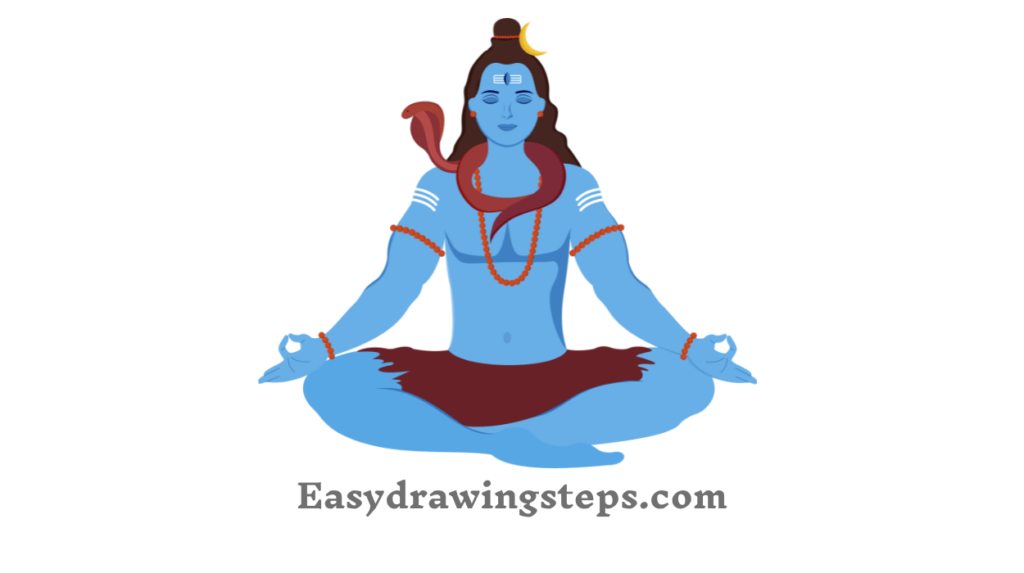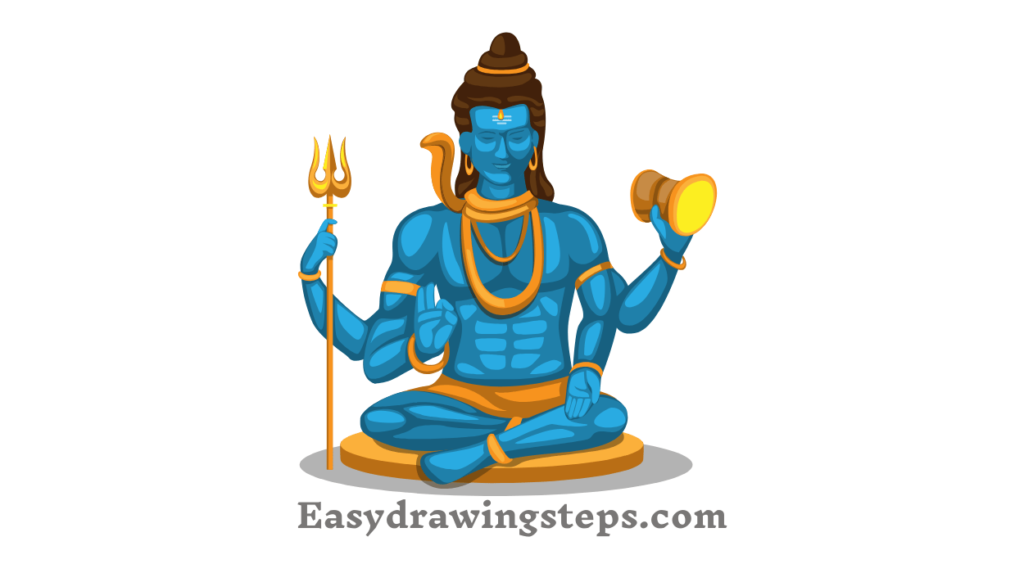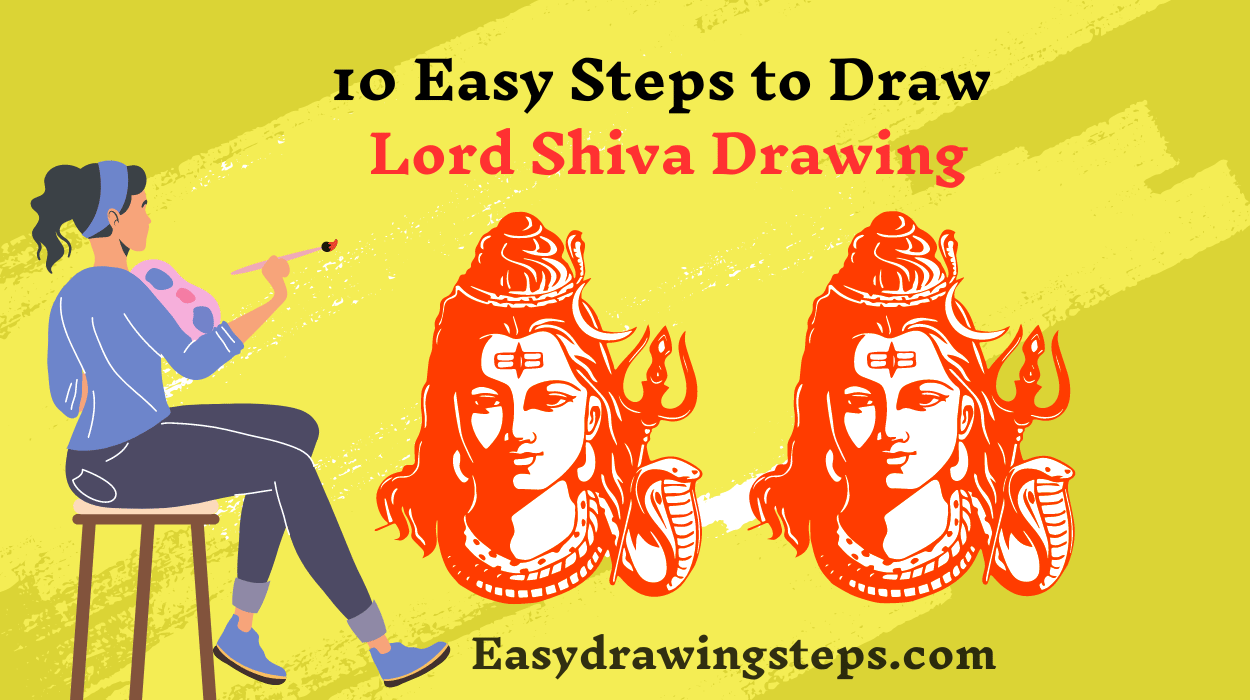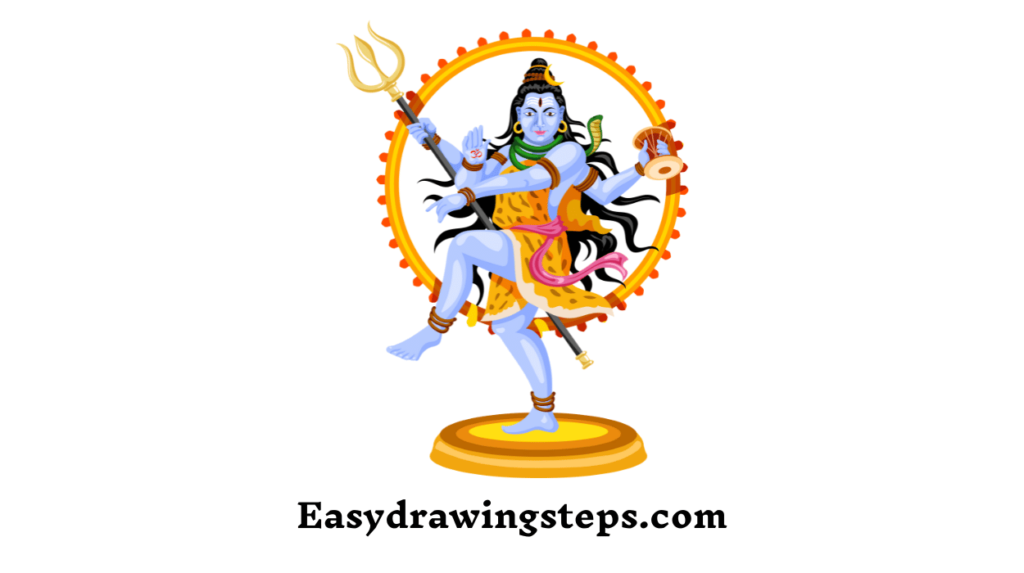Lord Shiva Drawing : Drawing Lord Shiva, the god of destruction and regeneration, is a deeply symbolic and spiritual process. Known for his calm demeanor, mystical appearance, and powerful features, Lord Shiva represents balance in the universe.
Whether you’re a beginner or an experienced artist, this step-by-step guide will help you bring Lord Shiva to life on paper.
Let’s explore the 10 easy steps to draw Lord Shiva.
Step 1: Draw the Basic Shape of the Face
Start with a simple oval shape for Lord Shiva’s face. Keep the bottom part of the oval narrower to represent the chin, and the top part wider to allow space for his hair and ornaments. This outline will serve as the foundation for your drawing.

Step 2: Add Guidelines for Facial Features
Draw a vertical line down the center of the face to divide it evenly. Add a horizontal line across the middle of the face where the eyes will sit. This will help you place the eyes, nose, and mouth symmetrically.
Also Read : 10 Steps to Draw Shiva Drawing Easy
Step 3: Draw the Eyes and Eyebrows
On the horizontal line, sketch two almond-shaped eyes. Shiva is often depicted with half-closed eyes, showing him in a state of meditation. Above the eyes, add gently curved, thick eyebrows that convey his calm and serene expression.
Step 4: Sketch the Nose and Mouth
Draw a long, straight nose starting from the center of the eyebrows down to just above the chin. For the mouth, sketch a simple, soft smile to show Lord Shiva’s peace and wisdom. Keep it subtle, as Shiva’s expression is typically calm and composed.

Step 5: Add the Third Eye
One of Shiva’s most important features is his third eye, located in the middle of his forehead. Draw a small vertical eye above the nose, between the eyebrows. This symbolizes Shiva’s divine wisdom and his power to see beyond the physical realm.
Step 6: Draw the Hair and Crescent Moon
Shiva’s hair is traditionally depicted as matted locks, tied up in a high bun. Start drawing wavy lines on the top of his head, and form a bun at the crown. Add the crescent moon on the right side of the bun, an important symbol of Lord Shiva’s control over time and cosmic energy.
Also Read : 10 Easy Steps to Draw Little Shiva Drawing
Step 7: Draw the Snake Around His Neck
A key element of Lord Shiva’s appearance is the snake coiled around his neck. Sketch a long snake wrapped around the neck, with its head resting on Shiva’s shoulder. The snake represents his mastery over fear, death, and danger.
Step 8: Sketch the Trident (Trishul) Behind Him
Shiva’s trident, or trishul, is his weapon and a symbol of his power over the three worlds—physical, mental, and spiritual. Draw the trident behind his shoulder with three sharp prongs at the top. Attach it to a long, vertical handle that stretches down behind his figure.
Also Read : 10 Easy Steps to Draw Shiva Drawing For Kids
Step 9: Add Rudraksha Beads and Other Ornaments
Shiva is often shown wearing a necklace of rudraksha beads. Sketch a string of small circular beads around his neck. You can also add other ornaments like bracelets or armlets to make the drawing more detailed and realistic.
Step 10: Shade and Refine the Drawing
Once the basic outline is complete, start adding shading to bring depth and dimension to your drawing. Shade around the eyes, nose, and lips to create more structure. Darken the hair, adding texture to the locks and the snake. Don’t forget to lightly shade the trident and crescent moon for a polished look.
- Use Colors: You can enhance your drawing by adding colors. Traditionally, Shiva is depicted with a blue or ash-grey skin tone, symbolizing his divine nature. Use golden or white shades for the crescent moon, and add earthy tones to the snake and rudraksha beads.
- Focus on Details: Pay attention to important details like the third eye, the crescent moon, and the trident, which are symbols of Shiva’s power and wisdom.
- Incorporate a Background: If you’d like to add more elements, consider drawing Mount Kailash, the Ganges river flowing from his hair, or a lotus at his feet.
Drawing Lord Shiva is not only a creative activity but also a meditative one. Each stroke of your pencil represents a piece of his divine essence, whether it’s his calm expression, powerful third eye, or mystical snake. We hope this step-by-step guide to drawing Lord Shiva has inspired you to bring this divine figure to life on paper.
Lord Shiva Drawing FAQ
What are the key elements to include when drawing Lord Shiva?
The key elements to include when drawing Lord Shiva are his serene face, the third eye on his forehead, the crescent moon in his hair, the snake coiled around his neck, his trident (trishul), and the rudraksha beads around his neck. His matted locks (often tied in a bun) are also an essential feature.
How can I draw Shiva’s face in a balanced and symmetrical way?
To ensure balance and symmetry in Shiva’s face, start by drawing a vertical guideline down the middle of the face. Then, add a horizontal guideline across the face where the eyes will be placed. These guidelines will help in aligning the eyes, nose, and mouth properly.
Why is the third eye an important feature of Lord Shiva’s drawing?
The third eye is a significant feature of Lord Shiva, symbolizing his wisdom, higher consciousness, and his ability to see beyond the physical world. It represents his control over destruction and creation and is essential for capturing his divine essence in the drawing.
Can beginners use colors when drawing Lord Shiva?
Yes! Beginners can use colors to bring their drawing of Lord Shiva to life. Traditionally, Lord Shiva is depicted with blue or grey skin tones, symbolizing his divinity and his association with cosmic energy. You can also use gold for the crescent moon, earthy tones for the snake, and dark shades for the hair.
What is the symbolism behind the snake around Shiva’s neck?
The snake around Lord Shiva’s neck symbolizes his mastery over fear, death, and time. It represents control over the physical world and his transcendent nature. Including the snake in the drawing emphasizes Shiva’s divine powers and his connection to life and death.



3 thoughts on “10 Easy Steps to Draw Lord Shiva Drawing”